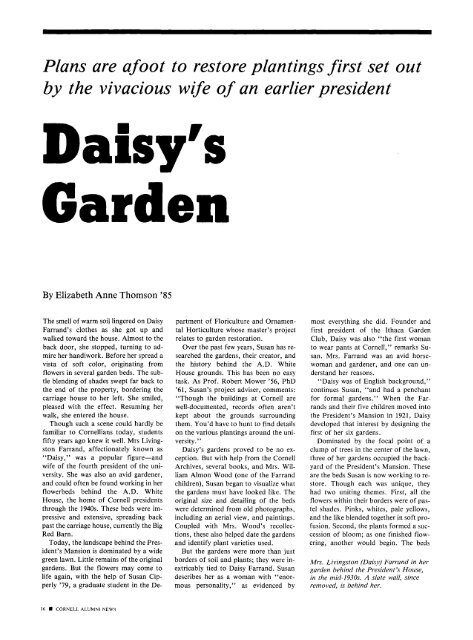Peru: you'll never see more species! - eCommons@Cornell - Cornell ...
Peru: you'll never see more species! - eCommons@Cornell - Cornell ...
Peru: you'll never see more species! - eCommons@Cornell - Cornell ...
You also want an ePaper? Increase the reach of your titles
YUMPU automatically turns print PDFs into web optimized ePapers that Google loves.
Plans are afoot to restore plantings first set out<br />
by the vivacious wife of an earlier president<br />
Daisy's<br />
Garden<br />
By Elizabeth Anne Thomson '85<br />
The smell of warm soil lingered on Daisy<br />
Farrand's clothes as she got up and<br />
walked toward the house. Almost to the<br />
back door, she stopped, turning to admire<br />
her handiwork. Before her spread a<br />
vista of soft color, originating from<br />
flowers in several garden beds. The subtle<br />
blending of shades swept far back to<br />
the end of the property, bordering the<br />
carriage house to her left. She smiled,<br />
pleased with the effect. Resuming her<br />
walk, she entered the house.<br />
Though such a scene could hardly be<br />
familiar to <strong>Cornell</strong>ians today, students<br />
fifty years ago knew it well. Mrs Livingston<br />
Farrand, affectionately known as<br />
"Daisy," was a popular figure—and<br />
wife of the fourth president of the university.<br />
She was also an avid gardener,<br />
and could often be found working in her<br />
flowerbeds behind the A.D. White<br />
House, the home of <strong>Cornell</strong> presidents<br />
through the 1940s. These beds were impressive<br />
and extensive, spreading back<br />
past the carriage house, currently the Big<br />
Red Barn.<br />
Today, the landscape behind the President's<br />
Mansion is dominated by a wide<br />
green lawn. Little remains of the original<br />
gardens. But the flowers may come to<br />
life again, with the help of Susan Cipperly<br />
'79, a graduate student in the De-<br />
CORNELL ALUMNI NEWS<br />
partment of Floriculture and Ornamental<br />
Horticulture whose master's project<br />
relates to garden restoration.<br />
Over the past few years, Susan has researched<br />
the gardens, their creator, and<br />
the history behind the A.D. White<br />
House grounds. This has been no easy<br />
task. As Prof. Robert Mower '56, PhD<br />
'61, Susan's project adviser, comments:<br />
"Though the buildings at <strong>Cornell</strong> are<br />
well-documented, records often aren't<br />
kept about the grounds surrounding<br />
them. You'd have to hunt to find details<br />
on the various plantings around the university."<br />
Daisy's gardens proved to be no exception.<br />
But with help from the <strong>Cornell</strong><br />
Archives, several books, and Mrs. William<br />
Almon Wood (one of the Farrand<br />
children), Susan began to visualize what<br />
the gardens must have looked like. The<br />
original size and detailing of the beds<br />
were determined from old photographs,<br />
including an aerial view, and paintings.<br />
Coupled with Mrs. Wood's recollections,<br />
these also helped date the gardens<br />
and identify plant varieties used.<br />
But the gardens were <strong>more</strong> than just<br />
borders of soil and plants; they were inextricably<br />
tied to Daisy Farrand. Susan<br />
describes her as a woman with "enormous<br />
personality," as evidenced by<br />
most everything she did. Founder and<br />
first president of the Ithaca Garden<br />
Club, Daisy was also "the first woman<br />
to wear pants at <strong>Cornell</strong>," remarks Susan.<br />
Mrs. Farrand was an avid horsewoman<br />
and gardener, and one can understand<br />
her reasons.<br />
"Daisy was of English background,"<br />
continues Susan, "and had a penchant<br />
for formal gardens." When the Farrands<br />
and their five children moved into<br />
the President's Mansion in 1921, Daisy<br />
developed that interest by designing the<br />
first of her six gardens.<br />
Dominated by the focal point of a<br />
clump of trees in the center of the lawn,<br />
three of her gardens occupied the backyard<br />
of the President's Mansion. These<br />
are the beds Susan is now working to restore.<br />
Though each was unique, they<br />
had two uniting themes. First, all the<br />
flowers within their borders were of pastel<br />
shades. Pinks, whites, pale yellows,<br />
and the like blended together in soft profusion.<br />
Second, the plants formed a succession<br />
of bloom; as one finished flowering,<br />
another would begin. The beds<br />
Mrs. Livingston (Daisy) Farrand in her<br />
garden behind the President's House,<br />
in the mid-1950s. A slate wall, since<br />
removed, is behind her.

















